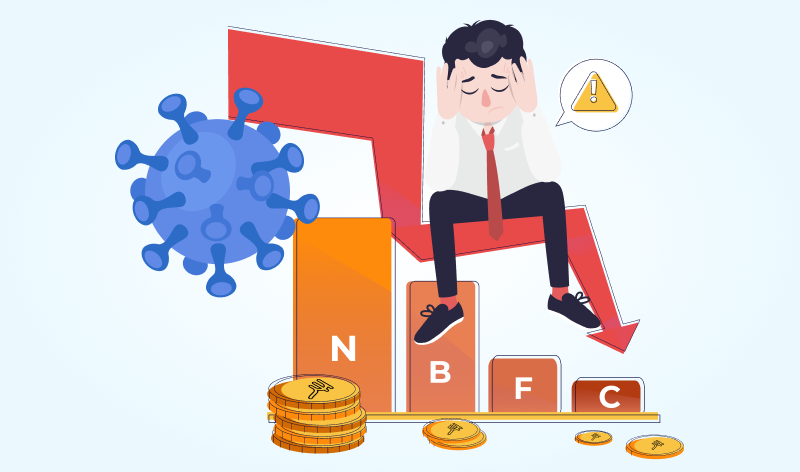NBFCs: The Changing Landscape Amidst the Pandemic

This post has been authored by Pratibha Saha, an Economic Analyst Intern at Arthashastra Intelligence.
The RBI defines an NBFC(Non-Banking Financial Company) in the following terms … “A Non-Banking Financial Company (NBFC) is a company registered under the Companies Act, 1956 engaged in the business of loans and advances, acquisition of shares/stocks/bonds/debentures/securities issued by Government or local authority or other marketable securities of a like nature, leasing, hire-purchase, insurance business, chit business…etc.
This sounds a lot like a traditional bank but NBFCs differ on the following grounds:
i.) They cannot accept demand deposits
ii.) They do not form part of the payment and settlement system and cannot issue cheques drawn on itself
iii.) Deposit insurance facility of Deposit Insurance and Credit Guarantee Corporation is not available to depositors of NBFCs, unlike in case of banks.
On the basis of their nature of activity ,the umbrella term of NBFCs usually encompasses the companies of Asset-Finance, Loan, Mortgage Guarantee,Investment,Infrastructure Finance,Micro-Finance as well as Housing Finance.
NBFCs, as institutions, emerged from the growing need to supplement banking infrastructure by bridging the gaping void of credit availability to small sector enterprises when traditional banks were too risk averse to do it. They also bring competition in financial services available in the country. Unlike regular banks offering a variety of services ,most NBFCs specialise in specific types of loans such as Muthoot Finance(gold loans),Bajaj Finance(automobile loans),etc.Even though they offer various banking services,they do not own a banking licence and are not held to the same regulatory standard of conventional banks and financial institutions which has been contributing to their overall growth over the years. Until, India had its own ‘Lehman’ moment.
On September 4th 2018, IL&FS defaulted on thousands of crores worth of loans.The rating agencies responsible for evaluating the company’s ability to pay back its debts changed the company’s ratings from AAA(highly rated) to zero overnight. NBFC stocks plummeted, created panic in the bond market and investor confidence took a turn for the worse. Even since then , meaningful investment has been sluggish to jumpstart.
Additionally, NBFCs traditionally had been a source of credit to many small, micro and medium enterprises (MSMEs) that were shunned by banks. Banks were only happy to lend to NBFCs because capital in NBFCs provided a sort of first-loss default guarantee to banks. Post the IL&FS episode, most NBFCs, excluding a few highly rated ones, suffered from lack of liquidity from both the banking system and the bond market, and hence, were forced to reduce their lending.
Corporate Affairs Secretary Injeti Srinivas opined in 2019 ,“There is a credit squeeze, over-leveraging, excessive concentration, massive mismatch between assets and liabilities, coupled with some misadventures by some very large entities, which is a perfect recipe for disaster”.
The already declining situation of the NBFCs has been made worse with the onset of the pandemic. As most NBFCs cannot raise funds on their own and depend on banks,who are themselves trying to manage the financial ramifications of the pandemic, the consequences have revealed themselves to be in the contraction of loan sanctions by NBFCs. As per April 2021 data , NBFC lending has seen a significant dip( 32%) amid Covid 2.0.
India’s deposit-taking banks are expected to see their bad loans rise to 12.5% and bank NPAs(Non-Performing Assets) are expected to climb to 9.6-9.7% in FY21 due to Covid.
The RBI,meanwhile, has been taking measures for the same. Our Finance Minister,in 2020, announced a Rs.30,000 crore special liquidity scheme for non-banking financial institutions to provide credit support to the sector amid the coronavirus crisis.Further, a Rs 45,000 crore partial credit guarantee scheme 2.0 was unveiled for non-banking financial companies (NBFCs), housing finance companies (HFCs) and microfinance institutions (MFIs) with low credit rating to help them extend loans to individuals and MSMEs. Even so,banks lending to NBFCs have been slow to pick up.
Moving forward some of the steps that could be taken to improve the crisis include high on-balance sheet liquidity to instill confidence among stakeholders, effective utilisation of retail bonds,securitisation and off-shore borrowings ,strengthening capital base to operate at lower leverage levels, digitisation,focusing on strengthening asset quality and similar measures.
References
- India, Ideas For. “A Decade of Credit Collapse in India.” Ideas For India, https://www.ideasforindia.in/topics/money-finance/a-decade-of-credit-collapse-in-india.html. Accessed 19 Sept. 2021.
- Roorkee, Finance Club, IIT. “NBFC Crisis in India. “We Have No Intention of Dismantling… | by Finance Club, IIT Roorkee | Medium.” Medium, Medium, 1 June 2020, https://medium.com/@financeclubiitr/nbfc-crisis-in-india-e2884d8ba15d.
- “Covid-19 Intensifies Headwinds for NBFCs.” Acuité Ratings & Research, https://www.acuite.in/Sector-alert-Covid-19-intensifies-headwinds-for-NBFCs.htm. Accessed 19 Sept. 2021.
“For Want of Liquidity, a Slowdown Is Born – The Financial Express.” The Financial Express, The Financial Express, 9 Sept. 2019, https://www.financialexpress.com/opinion/for-want-of-liquidity-a-slowdown-is-born/1700013/.
